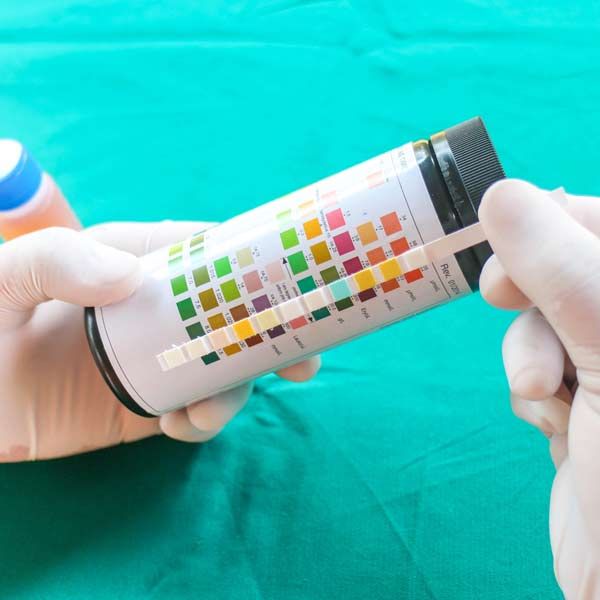Yeast Infection Treatments NYC - Dr. John Salerno

Yeast Infections Causes, Symptoms, and Integrative Medical Treatments by Salerno Wellness in Manhattan, NY, and Connecticut
I know having the symptoms of a yeast infection that don't go away can be very annoying and upsetting. I know how difficult it can be to have constant itching and irritation. You may have tried one or more remedies, but it seems like it just never goes away completely. I want to help you. I know what it is like to have a stubborn yeast infection that lingers. I know what you are going through, and I am here to help you. I am very familiar with all the different kinds of yeast infections and ways to get rid of them.
I will help you figure out what is going on and how to fix it. It's not just about covering up symptoms. I want to identify the root cause of your symptoms and treat them with the appropriate complementary, functional, and integrative therapies that will help your body heal itself and restore it to a state of homeostasis. I have helped many patients just like you over the past 30 years, and I am confident that we can find the cause of your illness and correct it so that you can regain your health and well-being.
-Dr. John Salerno
What is a Yeast Infection?
A yeast infection, or candidiasis, is an infection caused by an overgrowth of a fungus that lives naturally in the body, which is known as Candida. The human body is home to many microorganisms and bacteria, but one type of these natural bacteria is yeast. Yeast commonly lives on the outside of the body, especially on the skin, as well as on the inside of the body, for example, in the mouth, throat, gut, and vagina. However, in very small numbers, the yeast has little effect on the body. In some cases, the balance between your microorganisms can be disrupted, and the yeast will start to multiply and become out of control, which is when a yeast infection occurs.
Yeast infections are most often referred to as vaginal yeast infections; however, Candida yeast can also be present on the skin, nails, and mouth, and cause yeast infections there. The cause of yeast infections is not due to an outside pathogen entering the body; it is rather an imbalance of what is already present in your body. There are several things that can disrupt this balance and cause the Candida yeast to overgrow. Healing and correcting the problem must be seen as a long-term issue of restoring the internal body’s natural balance rather than a short-term "symptom management."
Common Symptoms of Chronic Yeast Infections
The symptoms of a yeast infection can vary depending on the location of the overgrowth, but they are almost always uncomfortable and disruptive. These signs are your body's way of signaling that an internal imbalance needs to be addressed. Recognizing these symptoms early can help you seek the right kind of care to not only alleviate the discomfort but also to address the root cause of the problem.
- Itching and Irritation: This is often the most prominent and distressing symptom, particularly with vaginal yeast infections. The itching can range from mild to intense and is often accompanied by significant irritation and inflammation of the affected tissues.
- Thick, White Discharge: A hallmark of vaginal candidiasis is a thick, white, cottage cheese-like discharge. This discharge is typically odorless and is a direct result of the fungal overgrowth altering the normal vaginal environment.
- Redness and Swelling: The area affected by the yeast overgrowth, such as the vulva or skin folds, may become visibly red and swollen. This inflammation is the body's immune response to the fungal proliferation and contributes to the overall discomfort.
- Burning Sensation: A burning feeling, especially during urination or sexual intercourse, is a common complaint. This sensation is caused by the inflamed and sensitive tissues coming into contact with urine or friction.
- Soreness and Pain: General soreness and pain in the affected area can make daily activities uncomfortable. This can manifest as a constant, dull ache or a sharp pain, depending on the severity of the infection.
- Rash or Skin Changes: In skin (cutaneous) candidiasis, a red rash may develop, often with satellite lesions or pustules around the main affected area. The skin may become cracked or macerated, particularly in warm, moist areas like under the breasts or in the groin.
- White Patches in the Mouth (Thrush): When Candida overgrows in the mouth, a condition known as oral thrush, it creates creamy white lesions on the tongue, inner cheeks, and sometimes the roof of the mouth or gums. These patches can be painful and may bleed slightly if scraped.

Christina Rosiello, Nurse Practitioner
Christina Rosiello is our Nurse Practitioner and has been working with Dr. John Salerno for years. Christina is very familiar with all of Dr. Salerno's Integrative and functional medical care practices and is fast becoming a favorite with patients. While Christina is comfortable with all areas of Salerno Wellness care, some patients have a preference regarding female issues such as PDMM, PMS, or any other hormonal or health issue, and Christina, being female, has quickly become a favorite.
Contact us to learn more about scheduling an appointment with Christine.
Common Causes of Yeast Infections
Yeast infections are fundamentally caused by an imbalance in your body's natural microbiome, allowing the Candida fungus to proliferate. Several factors can disrupt this delicate equilibrium, creating an environment where yeast can thrive. A diet high in sugar and refined carbohydrates is a primary contributor, as yeast feeds on sugar, and excessive intake provides an abundant food source for its growth. Antibiotic use is another major cause; while these medications are effective against harmful bacteria, they also eliminate the beneficial bacteria that help keep Candida levels in check.
Hormonal fluctuations, such as those occurring during pregnancy, menstruation, or from the use of oral contraceptives, can also alter the body's environment and encourage yeast overgrowth. Furthermore, a weakened immune system, whether due to stress, illness like HIV, or immunosuppressant medications, reduces the body's ability to control the fungal population. Conditions like uncontrolled diabetes also play a significant role, as high blood sugar levels create a yeast-friendly environment throughout the body.
Types of Yeast Infections
While most people associate yeast infections with the vaginal area, Candida can cause infections in various parts of the body. Understanding the specific type of infection is key to applying the most effective and targeted treatment plan.
- Vaginal Candidiasis: This is the most common form, affecting the vagina and vulva. It is characterized by itching, irritation, and a thick, white discharge, caused by an imbalance in the vaginal flora.
- Oral Thrush (Oropharyngeal Candidiasis): This infection occurs in the mouth and throat, presenting as white, creamy patches on the tongue and inner cheeks. It is most common in infants, the elderly, and those with compromised immune systems.
- Cutaneous Candidiasis: This type of yeast infection affects the skin, typically in warm, moist, and creased areas like the armpits, groin, and under the breasts. It results in a red, itchy rash that may develop pustules.
- Invasive Candidiasis: This is a serious, systemic infection where the Candida yeast enters the bloodstream and can spread to vital organs like the heart, brain, eyes, and bones. It primarily affects hospitalized patients or those with severely weakened immune systems and requires immediate, aggressive medical intervention.
- Candidal Onychomycosis: This refers to a yeast infection of the fingernails or toenails, causing them to become discolored, brittle, and thick. The nail may separate from the nail bed, and the surrounding skin can become red and swollen.
Related Medical Conditions That Can Be Treated
A chronic or recurring yeast infection is often a sign of a deeper, systemic issue that needs to be addressed. My functional medicine approach is designed to look beyond the immediate symptoms and investigate related conditions that may be contributing to the imbalance. By addressing these interconnected health issues, we can establish a foundation for long-term wellness and prevent future recurrences.
- Leaky Gut Syndrome: This condition, also known as increased intestinal permeability, allows partially digested food, toxins, and microbes to pass from the gut into the bloodstream, triggering systemic inflammation. A Candida overgrowth in the gut is a common cause of leaky gut, and addressing it is crucial for restoring intestinal health.
- Chronic Fatigue Syndrome: The toxins released by Candida overgrowth can place a significant burden on the body, leading to persistent and debilitating fatigue. By treating the underlying fungal issue and supporting the body's detoxification pathways, we can often see a dramatic improvement in energy levels.
- Fibromyalgia: The widespread pain and tenderness associated with fibromyalgia are often linked to chronic inflammation and immune system dysfunction. Systemic candidiasis can be a major contributing factor to this inflammatory state, and treating it can help reduce pain and other related symptoms.
- Autoimmune Disorders: An overgrowth of Candida can provoke an aggressive immune response, which in some individuals can lead to the development of autoimmune conditions. By restoring a healthy gut microbiome and calming the immune system, we can help manage the triggers that lead to autoimmune flare-ups.
- Irritable Bowel Syndrome (IBS): Symptoms of IBS, such as bloating, gas, constipation, and diarrhea, often overlap with those of a gut-based Candida overgrowth. Identifying and treating the yeast imbalance is a critical step in providing relief for many patients suffering from IBS.

Candidates for Treatment by Dr. John Salerno
Ideal candidates for my treatment approach are individuals who are frustrated with the cycle of recurring yeast infections and the temporary relief offered by conventional methods. These patients are often looking for a deeper understanding of why they are experiencing these issues and are motivated to make the necessary lifestyle and dietary changes to achieve lasting health.
Many patients have already tried multiple rounds of over-the-counter creams or prescription antifungal medications only to have their symptoms return. They may also be suffering from related symptoms like chronic fatigue, brain fog, digestive issues, and joint pain, suspecting that there is a more systemic problem at play.
My practice is well-suited for those who believe in a holistic model of care that considers the whole person, mind, body, and spirit. Patients who are ready to become active partners in their own healing journey and are open to integrative therapies like nutritional counseling, detoxification, and targeted supplementation will find the most success with my personalized protocols.
How Conventional Medicine Treats Yeast Infections
The conventional medical approach to treating yeast infections typically focuses on eradicating the fungus with antifungal medications. For a simple vaginal yeast infection, a doctor will usually recommend a short course of treatment, either with an over-the-counter or prescription antifungal cream, ointment, tablet, or suppository. Commonly used medications include miconazole, clotrimazole, and tioconazole. For more complicated or recurrent infections, a longer course of treatment may be prescribed, or a single or multi-dose oral antifungal medication, such as fluconazole, may be used.
While these treatments are often effective at clearing the immediate symptoms, their primary limitation is that they do not address the underlying reasons for the yeast overgrowth in the first place. This approach can lead to a cycle of recurring infections, as the factors that created the imbalance, such as diet, gut health, or hormonal issues, remain unaddressed.
Dr. John Salerno's Approach to Yeast Infection Treatments
My approach to treating yeast infections goes beyond simply managing symptoms; it is centered on identifying and correcting the root cause of the Candida overgrowth. We begin with comprehensive diagnostic testing to assess the extent of the yeast issue and identify any co-existing conditions, such as leaky gut, heavy metal toxicity, or nutritional deficiencies. Based on these findings, I create a highly personalized treatment plan that employs a multi-faceted strategy to restore your body's natural balance.
This protocol includes a specific anti-Candida diet designed to starve the yeast by eliminating sugars and fermented foods. We then use powerful, natural antifungal agents to reduce the yeast population, followed by high-quality probiotics to replenish the beneficial bacteria in your gut. This functional medicine strategy ensures we are not just silencing the alarm but fundamentally putting out the fire, leading to long-term relief and improved overall health.
Possible Side Effects of Treatment
As we begin to address the root cause of candidiasis, some patients may experience a die-off reaction, also known as a Herxheimer reaction. This occurs when the yeast cells are killed off rapidly, releasing a surge of toxins into the bloodstream faster than the body can eliminate them. Symptoms can temporarily include fatigue, headache, body aches, digestive upset, and a brief worsening of the initial yeast infection symptoms. While this can be uncomfortable, it is actually a positive sign that the treatment is working effectively. We manage these potential side effects carefully by supporting the body's detoxification pathways with targeted supplements, proper hydration, and therapies to ensure the process is as gentle and tolerable as possible for the patient.
What Can Happen if a Yeast Infection is Left Untreated?
Leaving a yeast infection untreated, especially if it is chronic or recurring, can lead to more significant health complications over time. A localized infection can spread, and in the case of gut-based Candida, it can contribute to the development of leaky gut syndrome. This condition compromises the intestinal lining, allowing toxins and undigested food particles to enter the bloodstream, which can trigger systemic inflammation and food sensitivities.
Chronic inflammation is a root cause of many other health problems, including autoimmune diseases, joint pain, and skin conditions such as eczema and psoriasis. Over time, the constant burden on the immune system can lead to chronic fatigue and brain fog, significantly diminishing one's quality of life. In rare cases, for individuals who are severely immunocompromised, an untreated yeast infection can become invasive, entering the bloodstream and threatening vital organs.
Patient Case Study
Sarah, a 38-year-old marketing executive, came to my office at her wits' end, having battled recurrent vaginal yeast infections for nearly three years. She had been through countless rounds of conventional antifungal creams and oral medications, which would provide temporary relief for a few weeks before the agonizing itching and discomfort returned. Beyond the localized symptoms, Sarah also complained of persistent brain fog, bloating after every meal, and a deep fatigue that her morning coffee could no longer touch. Her primary care physician had offered no solutions beyond more prescriptions. We started with comprehensive testing, which confirmed a significant Candida overgrowth in her gut, along with leaky gut and several food sensitivities.
I placed Sarah on a strict anti-Candida diet, removing all sugars, gluten, and dairy. Her personalized protocol also included natural antifungal supplements, liver support to manage die-off symptoms, and a high-potency probiotic. Within three weeks, Sarah reported that her brain fog was lifting for the first time in years. By the six-week mark, her digestive issues had resolved, her energy levels were soaring, and most importantly, she was completely free of her yeast infection symptoms. Today, Sarah remains symptom-free by maintaining a modified, healthy diet and has a new understanding of how to listen to her body.
Why Patients Choose Dr. John Salerno for Yeast Infection Treatments
Patients choose me because they are seeking a partnership in health that looks beyond a simple prescription pad. They come to my practice because they are tired of being told their chronic symptoms are normal or are just something they have to live with. With over 30 years of experience in functional and integrative medicine, I offer a level of expertise and a depth of investigation that is difficult to find in conventional healthcare. My approach is rooted in the belief that the body has an innate capacity to heal itself when given the proper support.
We utilize advanced diagnostic testing to uncover the intricate web of factors contributing to a patient's illness, from gut health to hormonal balance and environmental toxins. This enables the creation of truly personalized and precise treatment plans that address the underlying cause, rather than merely masking symptoms. Patients appreciate the time I take to listen to their stories and the dedication I have to educating and empowering them on their journey back to optimal health.
Contact Dr. John Salerno For A Consultation on Yeast Infection Treatments in Manhattan, NY, and Connecticut
Dealing with chronic yeast infections can be a deeply frustrating and isolating experience, but it is crucial to know that lasting relief is possible. The key is to move beyond temporary fixes and address the fundamental imbalances within your body that allow Candida to flourish. Through a comprehensive, functional medicine approach, we can identify and address the root causes, including diet, gut health, and immune function.
This method not only resolves recurring infections but also helps alleviate related issues, such as fatigue, digestive distress, and brain fog, leading to a profound improvement in your overall well-being.
You do not have to continue the cycle of symptoms and ineffective treatments. Take the first step toward reclaiming your health and vitality. Contact Salerno Wellness today to schedule a consultation and discover how personalized, integrative care can help you finally achieve long-term freedom from yeast infections.
Please contact us today.
Additional References
- Clinical Overview of Invasive Candidiasis - US Centers for Disease Control and Prevention
- Vaginal yeast infections - Office on Women's Health



